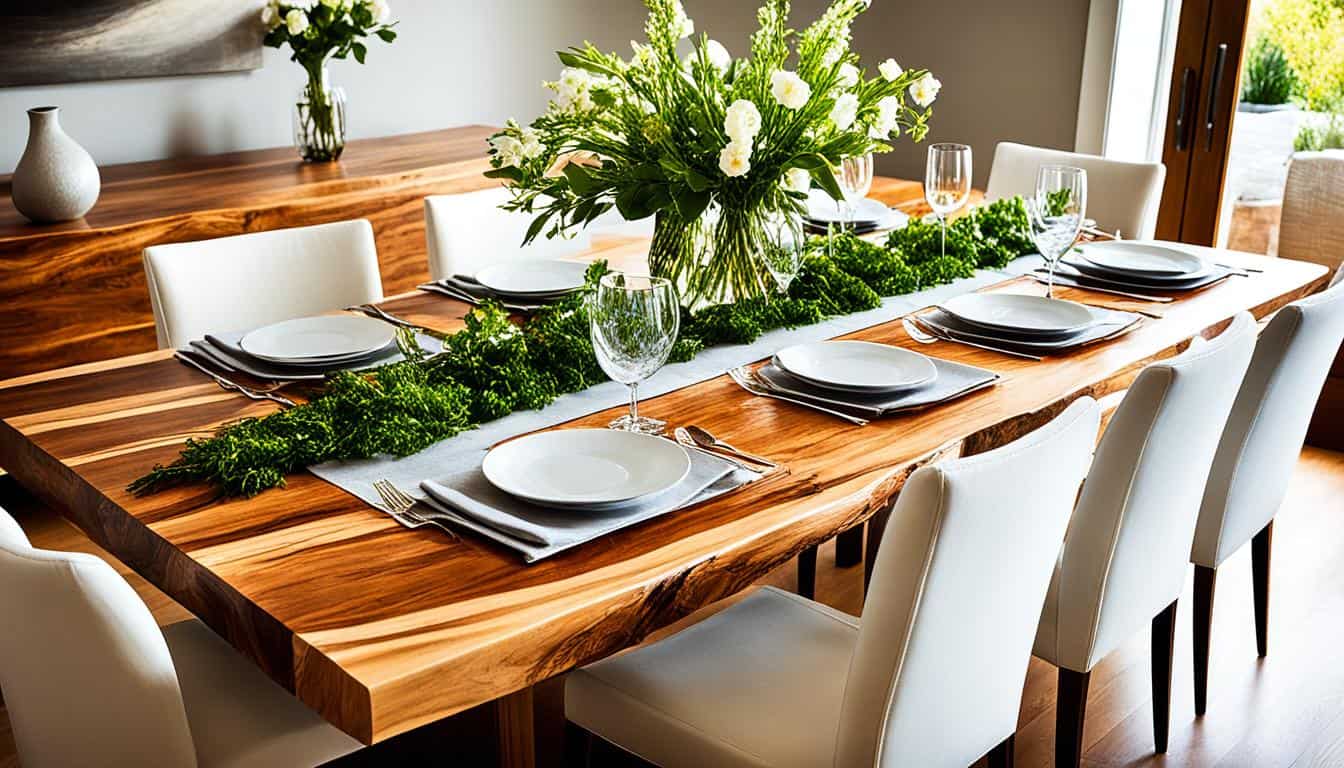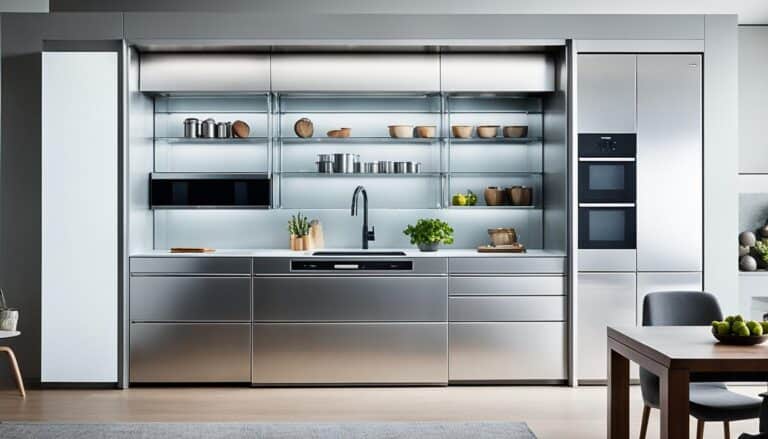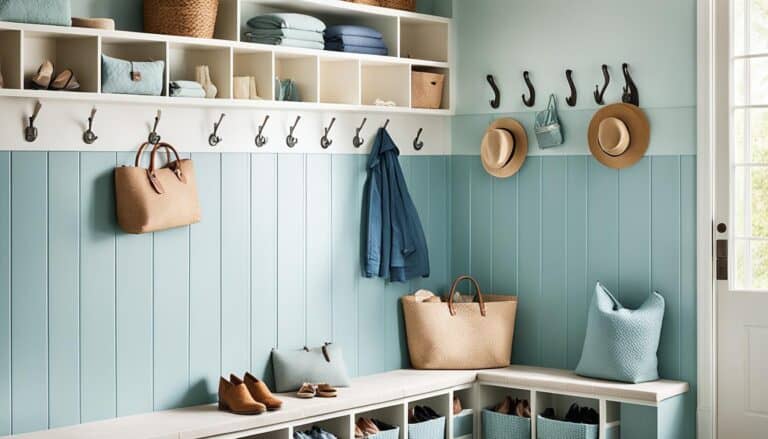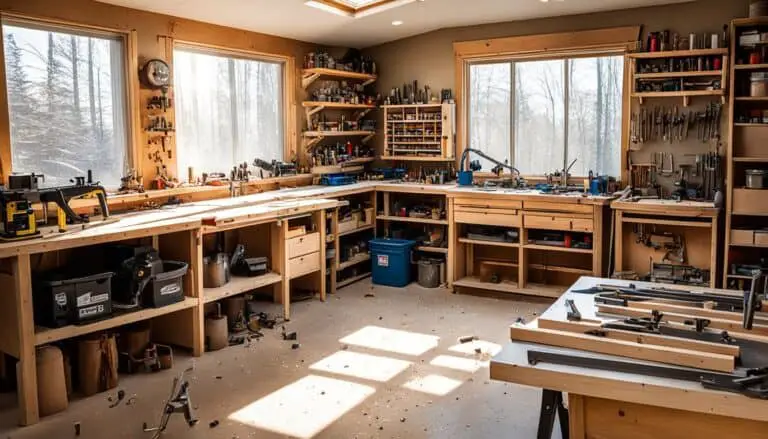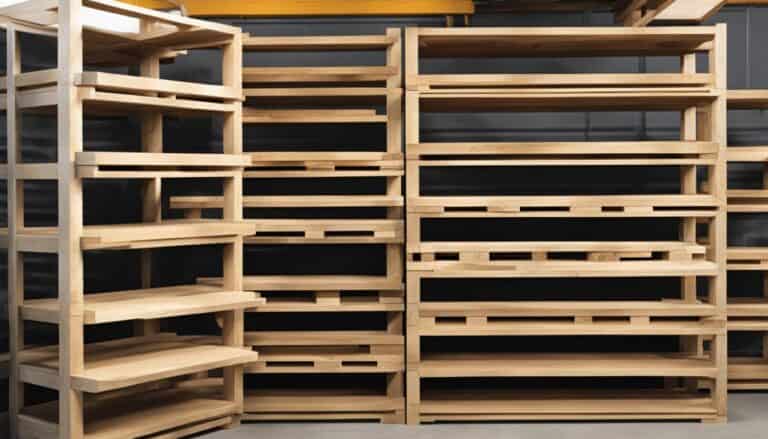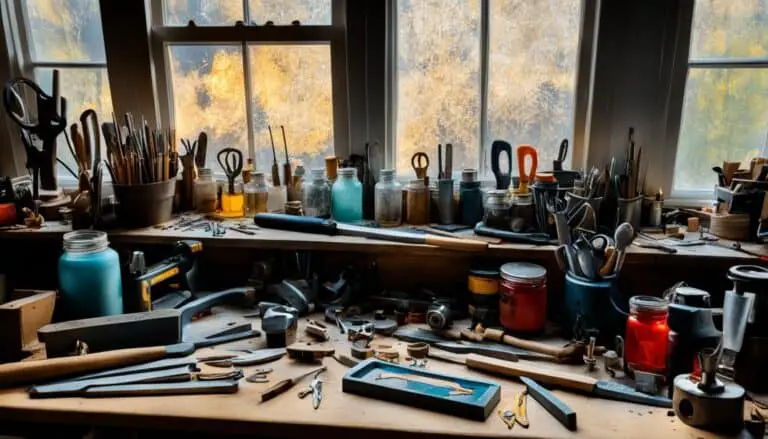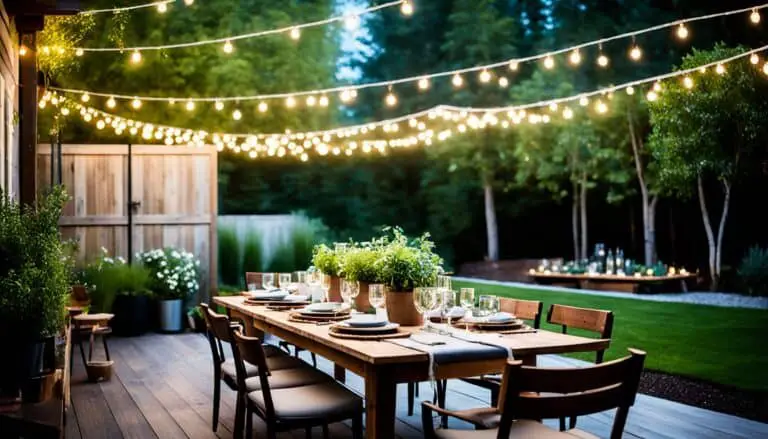When it comes to selecting the best wood for your dining table, there are several factors to consider. The wood’s appearance, durability, and cost all play a crucial role in finding the perfect choice for your needs. In this article, we will explore the top dining table wood choices, highlighting the high-quality and durable options available. Whether you prefer a hardwood or softwood dining table, we’ll provide you with the information you need to make an informed decision.
Key Takeaways:
- The appearance of the wood, including grain pattern and color, should be considered when selecting a dining table wood.
- Durability is important for withstanding everyday wear and tear.
- Cost varies depending on the type of wood, so consider your budget when making a decision.
- Hardwood is known for its durability, while softwood offers affordability and workability.
- Wood selection can impact the overall aesthetics of your dining space.
Introduction to Selecting Dining Table Wood
When it comes to choosing the best wood for your dining table, there are several important factors to consider. Selecting the right wood can make a significant difference in both the aesthetic appeal and durability of your table. In this section, we will provide an overview of the key considerations when selecting dining table wood and introduce some of the top wood choices for dining tables.
First and foremost, the appearance of the wood is an essential factor to consider. The grain pattern, color, and texture of the wood can greatly influence the overall look and feel of your dining space. Whether you prefer a rustic, distressed look or a sleek, modern design, different wood types offer a range of aesthetic possibilities.
Durability is another crucial aspect to bear in mind. A dining table is subjected to daily wear and tear, including scratches, dents, and spills. Therefore, selecting a wood that is known for its durability and ability to withstand these challenges is paramount.
Cost is also a significant consideration for many individuals. Different wood types come at varying price points, so it’s important to choose one that fits within your budget without compromising on quality.
Maintenance is yet another factor to keep in mind. Some wood types require more care and upkeep than others. Consider how much time and effort you are willing to invest in maintaining the beauty of your dining table.
Throughout this article, we will explore in detail the different wood types that are popular for dining tables and delve into their unique characteristics. By understanding the various options available, you will be equipped to make an informed decision and select the best wood for your dining table that matches both your personal taste and practical needs.
The Aesthetic Appeal of Different Wood Types
When it comes to dining tables, the aesthetic appeal of different wood types plays a significant role in enhancing the overall look of your dining space. The unique grain patterns, color variations, and natural beauty of wood can transform an ordinary table into a statement piece.
Each wood species has its own distinctive characteristics, offering a wide range of options to match your design schemes. Whether you prefer the rich warmth of mahogany, the rustic charm of oak, or the sleek elegance of walnut, there is a wood type that can perfectly complement your dining area.
Wood finishes further enhance the appearance of the wood, bringing out its natural beauty and protecting it from daily wear and tear. By applying the right finish, you can highlight the wood’s grain patterns and intensify its color variations, creating a stunning visual effect.
For example, a dining table made from maple wood with a clear, glossy finish can showcase its smooth, even grain pattern, while a table crafted from cherry wood with a satin finish can highlight the natural reddish-brown hue and deep grain lines.
Take a moment to appreciate the aesthetic appeal of different wood types in the image below:
As you can see, the variety of wood grain patterns, colors, and textures offer endless possibilities for creating a one-of-a-kind dining table that reflects your personal style and tastes. Consider the aesthetic appeal of different wood types when choosing the perfect dining table for your home.
Navigating Durability and Maintenance Needs
This section will address the durability and maintenance needs of dining table wood. It is crucial to select a wood type that can withstand everyday use, scratches, and dents, ensuring the longevity of your dining table. To assess the durability of different wood types, it is helpful to understand the Janka hardness scale. This scale measures the hardness of various wood species and can guide your decision-making process.
Understanding the Janka Hardness Scale
The Janka hardness scale provides a standardized measurement of wood hardness. It determines the resistance of a wood species to indentation and wear, making it an essential consideration for dining tables. By referencing the Janka hardness rating, you can select a wood type that suits your durability requirements. For example, woods with higher ratings, like Brazilian Walnut or Red Oak, are exceptionally durable and ideal for high-traffic areas.
Longevity and Preservation of Wood
Preserving the longevity and natural beauty of your dining table wood requires proper maintenance. Regular cleaning, using a soft cloth and mild wood cleaner, helps remove dust and prevent buildup. Additionally, protecting the wood from direct sunlight and excessive heat can prevent fading and warping. Applying a protective finish, such as lacquer or polyurethane, can enhance the wood’s resistance to stains and spills. Implementing these preservation techniques can extend the lifespan of your dining table and maintain its visual appeal for years to come.
Comparing Costs of Popular Dining Table Wood Types
When it comes to selecting the perfect wood for your dining table, cost is an important consideration. The price of wood can vary depending on the species and quality, making it essential to compare the costs of different wood types before making a decision. To help you make an informed choice that aligns with your budget and preferences, here are examples of both affordable and more expensive wood types for dining tables:
Affordable Wood Types: These wood types offer durability and aesthetic appeal at a lower price point, making them an excellent choice for budget-conscious individuals. Some popular affordable wood types include:
- Pine
- Oak
- Maple
- Birch
Expensive Wood Types: These wood types are known for their unique features and natural beauty, making them more expensive options. If you have a larger budget and are seeking a luxurious dining table, consider these high-end wood types:
- Walnut
- Cherry
- Mahogany
- Teak
By comparing the costs of different wood types, you can choose a dining table wood that suits your budget while still providing the desired aesthetics and durability. Remember to consider other factors such as maintenance requirements and compatibility with your overall design scheme when making your final decision.
Hardwood Versus Softwood for Tables
When it comes to selecting the perfect wood for your dining table, you have a choice between hardwood and softwood. Both options have their own unique characteristics and advantages that cater to different preferences and needs. Let’s explore the characteristics of hardwood and the benefits of softwood for furniture, helping you make an informed decision.
Characteristics of Hardwood
Hardwood is known for its exceptional durability, strength, and density, making it a popular choice for dining tables. With its dense cellular structure, hardwood provides resistance to wear and tear, ensuring your table withstands everyday use and remains in top condition for years to come. Additionally, hardwood boasts beautiful grain patterns and rich colors, enhancing the visual appeal of your dining space.
Some common hardwood options for dining tables include oak, maple, walnut, and mahogany. These species offer exceptional durability and can lend an elegant and timeless look to your dining area. However, it’s important to note that hardwood options may come at a higher price point compared to softwood.
Benefits of Softwood for Furniture
Softwood, on the other hand, offers distinct advantages that make it a practical choice for furniture, including dining tables. Softwood is generally more affordable compared to hardwood, making it a budget-friendly option for those seeking high-quality furniture without breaking the bank. Additionally, softwood is easier to work with, allowing for intricate detailing and customized designs.
Popular softwood choices for furniture include pine, cedar, and fir. These species bring a natural warmth and charming aesthetic to your dining space. While softwood might not have the same level of density and strength as hardwood, it still offers sufficient durability for everyday use.
Ultimately, the decision between hardwood and softwood for your dining table depends on your personal preferences, budget, and specific needs. Consider factors such as the level of durability required, the desired aesthetic appeal, and the budget constraints when making your choice. By understanding the characteristics and benefits of each wood type, you can select the option that best suits your lifestyle and enhances your dining experience.
Implications of Wood Grain and Color Variations
In the world of dining tables, the aesthetic appeal goes beyond the choice of wood type. Wood grain patterns and color variations play a significant role in creating a visually stunning and harmonious dining space.
The natural beauty of wood grain patterns adds character and texture to the dining table, making it a focal point in the room. From the smooth and elegant straight grain to the bold and eye-catching curly or burl grain, each pattern tells a unique story. By selecting a wood with a grain pattern that complements your decor, you can create a cohesive and inviting atmosphere.
Wood color variations are another essential factor to consider when choosing a dining table. The color of the wood can dramatically impact the overall look and feel of the space. Light-colored woods, like maple or pine, can create an airy and contemporary ambiance, while dark-colored woods, such as walnut or mahogany, can evoke a sense of elegance and warmth.
Matching the wood grain and color with your decor is crucial in achieving a cohesive and visually appealing dining space. Take into account the existing furnishings, such as chairs, cabinets, or flooring, and choose wood with grain patterns and color variations that harmonize and enhance the overall design scheme.
Wood grain and color variations have a profound impact on the dining space, influencing its atmosphere and style. By carefully considering these factors, you can create a dining area that reflects your personal taste and complements your decor beautifully.
Assessing High-Quality Dining Table Wood Choices
In order to ensure your dining table is both durable and visually appealing, it is crucial to assess high-quality wood choices. By selecting the best wood for furniture endurance, you can guarantee that your dining table will stand the test of time. Additionally, considering wood types that exude natural beauty will enhance the overall aesthetics of your dining space.
Best Wood for Furniture Endurance
When it comes to durability and longevity, certain wood types surpass others. These high-quality woods are known for their exceptional strength and resistance to wear and tear. Maple and oak are two popular choices that are widely recognized for their endurance and ability to withstand daily use. These hardwoods are highly durable and are commonly used in the construction of high-quality dining tables. Their dense nature and sturdy build make them ideal for furniture that needs to withstand everyday activities.
Wood Types That Exude Natural Beauty
While durability is essential, it is equally important to consider the natural beauty that wood can bring to your dining table. Choosing a wood type that exudes natural beauty will not only enhance the visual appeal of your dining space but also create a warm and inviting atmosphere. Walnut and cherry are excellent examples of wood types that offer both durability and natural beauty. Walnut is known for its rich, dark color and unique grain patterns, while cherry boasts a warm reddish hue and elegant figuring.
By assessing high-quality dining table wood choices, such as maple, oak, walnut, and cherry, you can ensure that your dining table is not only built to last but also showcases the exquisite natural beauty of wood. These enduring wood types provide the perfect combination of durability and aesthetics, making them an excellent choice for any dining space.
Making Practical Decisions: Durable Wood for Dining Table
When it comes to selecting wood for your dining table, practicality should be a top consideration. Choosing a durable wood that can withstand the demands of everyday use is essential for ensuring the longevity of your table. Additionally, considering your usage and lifestyle factors is crucial in making practical decisions for the type of wood that will best suit your needs.
To begin with, think about how often you will be using the dining table and the level of wear and tear it will experience. If you have a busy household with children or frequently entertain guests, you will want to opt for a wood that is known for its durability. Hardwoods such as oak, maple, and walnut are excellent choices that can handle heavy use without showing significant signs of wear.
Moreover, consider the maintenance requirements of different wood types. Some woods require more frequent cleaning, polishing, or refinishing to keep them looking their best. If you prefer a low-maintenance option, you may want to choose a wood with a more forgiving finish or one that naturally ages beautifully over time.
Another practical consideration is the availability and cost of the wood. Some woods may be harder to come by or more expensive, which can impact your decision-making process. However, it’s important to strike a balance between cost and quality. Don’t compromise on the durability and longevity of your dining table for the sake of saving a few dollars.
Lastly, think about the overall aesthetic of your space when selecting wood for your dining table. Consider how the wood will complement your existing decor and furnishings. You may want to choose a wood with a grain pattern and color variation that matches or enhances the overall design scheme of your dining room.
Making practical decisions about the type of wood for your dining table will ensure that you have a piece of furniture that not only looks beautiful but also stands the test of time. By considering factors such as durability, maintenance, cost, and aesthetic appeal, you can make an informed decision that meets your needs and enhances your dining experience.
Best Wood for Dining Table Based on Janka Ratings
In order to select the best wood for your dining table, it is important to consider the Janka hardness ratings of different wood types. The Janka hardness scale measures the resistance of a wood species to indentation and wear, providing insight into its durability and suitability for daily use. By choosing a wood with a high Janka rating, you can ensure that your dining table will be able to withstand the impact of regular use and maintain its beauty for years to come.
Distinguishing Wood Hardness
The Janka hardness scale assigns a numerical value to each wood species, indicating its relative hardness. These ratings can help you compare different wood types and determine their suitability for a dining table. Hardwoods generally have higher Janka ratings than softwoods, making them more resistant to scratches and dents. Some popular hardwoods with high Janka ratings include:
- Oak: Oak wood is known for its strength and durability, making it a popular choice for dining tables. With its Janka hardness rating ranging from 1290 to 1360, oak can withstand the demands of daily use.
- Maple: Maple is another hardwood with excellent durability, boasting a Janka hardness rating of 1450. Its tight grain pattern and natural luster make it an attractive option for dining tables.
- Cherry: Cherry wood, while slightly softer than oak and maple, still offers a respectable Janka hardness rating of 950. Its warm reddish-brown color and smooth texture make it a popular choice for elegant dining tables.
In contrast, softwoods such as pine and cedar have lower Janka ratings, making them more prone to scratches and dents. However, softwoods can still be suitable for dining tables if they are properly cared for and maintained.
Impact of Hardness on Daily Use
The hardness of the wood used in your dining table can significantly impact its performance and lifespan. A dining table made from a wood with a high Janka rating will be more resistant to everyday wear and tear, ensuring that it remains in excellent condition over time. This means that you won’t have to worry as much about accidental scratches or dents caused by utensils, serving dishes, or other items commonly used on a dining table.
Additionally, a dining table with a high Janka rating will be more durable and less likely to warp or splinter. This can be particularly important if you have young children or frequently entertain guests, as the table will need to withstand heavy use and potential impacts.
By considering the Janka hardness ratings of different wood types and selecting a wood with a high rating, you can confidently choose the best wood for your dining table. This will ensure that your table not only looks beautiful but also withstands the rigors of daily use, providing you with a long-lasting and resilient piece of furniture.
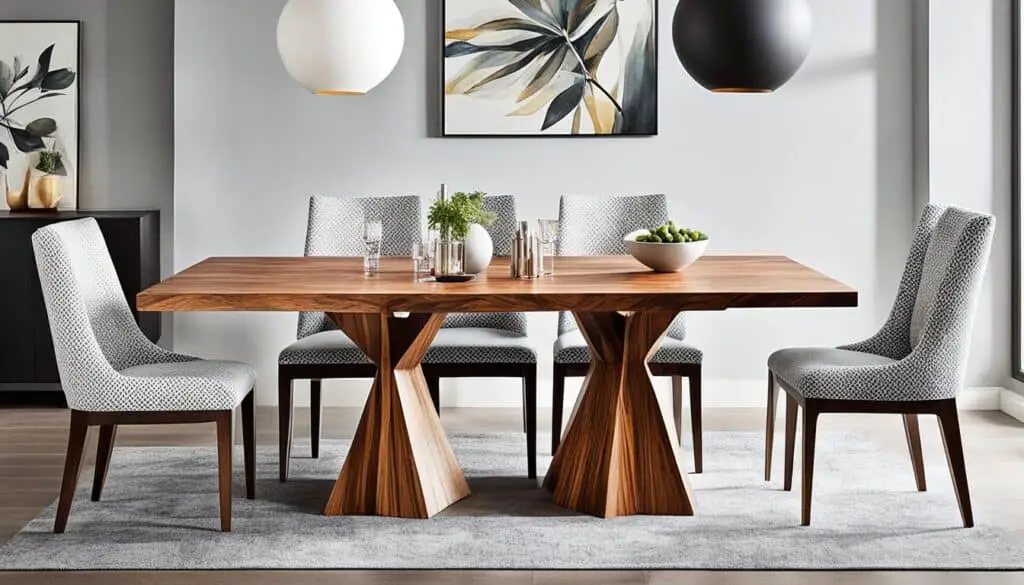
Styling Your Space: How Wood Selection Influences Décor
When it comes to styling your dining space, the wood selection plays a crucial role in influencing the overall décor. Choosing the right wood can create a cohesive and visually pleasing environment that enhances the look and feel of your dining area.
Matching Wood with Design Schemes
One of the key considerations in styling your dining space is matching the wood with your design schemes. Different wood types have their own unique grain patterns, colors, and textures, which can either complement or clash with your existing décor. By selecting wood that harmonizes with your design scheme, you can create a cohesive and visually appealing space.
For example, if your dining area has a modern and minimalist theme, you may opt for a sleek and smooth wood with clean lines, such as walnut or maple. On the other hand, if you have a rustic or farmhouse-style dining space, a distressed or reclaimed wood, like oak or pine, can add warmth and character.
It’s important to consider the existing colors and materials in your dining area as well. If you have a lot of neutral tones, a dark wood, such as mahogany or cherry, can provide a striking contrast. Alternatively, if you want a more monochromatic look, you can choose a wood with similar tones to the rest of your décor.
Transforming Spaces with Wood Finishes
In addition to wood selection, wood finishes can also play a significant role in transforming your dining space. Finishes not only protect the wood from damage and wear but also add depth and character to the surface.
There are various types of wood finishes available, each offering its own unique look and level of durability. Some popular options include staining, varnishing, and oiling. Stains can enhance the natural color of the wood or provide a different hue altogether. Varnishes offer a glossy and protective layer, while oils can bring out the natural beauty of the wood and provide a more matte finish.
By choosing the right wood finish, you can further enhance the appearance of your dining table and create a personalized touch. Whether you prefer a contemporary, traditional, or eclectic style, the right finish can transform your dining space to reflect your unique taste and personality.
To inspire you, here’s an image showcasing how wood selection and finishes can significantly impact the overall look and feel of a dining space:
As you can see, the right wood selection and finish can completely transform the dining space, elevating its style and aesthetics. With careful consideration and creativity, you can achieve a stunning and personalized dining area that reflects your design preferences.
Choosing Wood Based on Your Lifestyle and Usage
When selecting wood for your dining table, it’s essential to consider your lifestyle and usage requirements. Different individuals have unique needs, and choosing the right wood can ensure that your table withstands the demands of everyday use. Here are some factors to consider:
- Frequency of use: If you frequently use your dining table, it’s important to choose a wood type that is durable and can withstand regular wear and tear. Hardwood options such as oak, maple, or cherry are known for their strength and longevity.
- Family dynamics: If you have young children or a large family, you may want to opt for a wood that is more resistant to scratches and stains. Hardwoods with a higher Janka hardness rating, such as mahogany or walnut, can be a good choice.
- Specific usage requirements: Consider how you plan to use your dining table. If you regularly host dinner parties or entertain guests, you might want a wood type that showcases natural beauty and elegance, such as walnut or ash.
By taking into account your specific lifestyle and usage needs, you can select the perfect wood for your dining table that not only complements your space but also stands the test of time.
Types of Finishes to Protect and Enhance Your Table
In order to ensure the durability and visual appeal of your dining table, it is important to choose the right finish. The finish not only protects the wood from stains, scratches, and moisture, but also enhances its natural beauty. There are various options available for durable finishing, each with its own benefits and drawbacks. By understanding the different types of finishes and their characteristics, you can make an informed decision that suits your needs.
Options for Durable Finishing
1. Varnishes: Varnishes are popular finishes that provide a protective layer on the surface of the wood. They offer excellent durability and resistance to wear and tear. Varnishes come in different finishes, such as glossy, satin, and matte, allowing you to choose the level of shine that suits your preference. However, varnishes can be more challenging to apply and may require multiple coats for optimal results.
2. Oils: Oils, such as tung oil and linseed oil, penetrate the wood fibers, enhancing its natural color and grain patterns. They provide a natural, low-sheen finish and are easy to apply. Oiled finishes require regular maintenance and reapplication to keep the wood well-protected. They may not provide as much protection against water and stains compared to varnishes.
3. Oil-Wax Finishes: Oil-wax finishes combine the benefits of both oils and waxes. They penetrate the wood like oils, highlighting its natural beauty, and also leave a protective layer on the surface like waxes. Oil-wax finishes offer a soft, matte appearance and are relatively easy to maintain. However, they may require periodic reapplication to ensure maximum protection.
It’s important to note that each finish may react differently with different wood types, so it’s recommended to test the finish on a small, inconspicuous area before applying it to the entire table.
Tips for Maintaining Wood Table Finishes
In order to maintain the quality and appearance of your wood table finish, consider the following tips:
- Use coasters, placemats, and trivets to protect the table from heat, moisture, and spills.
- Avoid dragging or sliding heavy objects across the table surface to prevent scratches.
- Regularly dust the table with a soft, lint-free cloth to remove any dirt or debris.
- Use a mild soap and water solution or a designated wood cleaner for periodic cleaning.
- Avoid using harsh chemicals or abrasive cleaners that can damage the finish.
- Periodically apply a fresh coat of the chosen finish to maintain its protective properties.
By following these maintenance tips, you can extend the life of your dining table finish and keep it looking beautiful for years to come.
Choose a finish that suits your style and maintenance preferences, and enjoy the long-lasting protection and enhanced beauty it brings to your dining table.
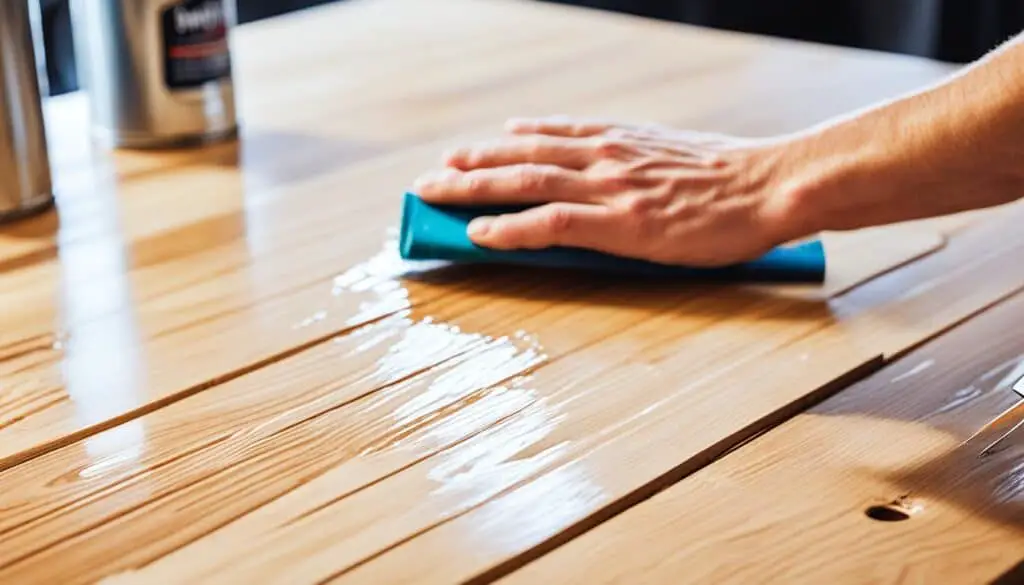
Conclusion
In conclusion, selecting the best wood for your dining table is a crucial decision that requires careful consideration. Throughout this article, we have explored the key factors to keep in mind when choosing the right wood for your dining table.
First and foremost, the appearance of the wood, including the grain pattern, color, and texture, plays a significant role in enhancing the overall aesthetic of your dining space. It is important to select a wood type that complements your existing decor and design schemes.
Additionally, durability is of utmost importance when it comes to dining tables. You want a wood type that can withstand the daily wear and tear, including scratches and dents. Considering the Janka hardness scale can help you determine the durability of different wood species.
Furthermore, the cost and maintenance aspect should not be overlooked. Different wood types come at varying price points, so it’s important to choose a wood that fits within your budget. Additionally, selecting a wood finish that protects and enhances your dining table can contribute to its longevity and visual appeal.
Overall, choosing the best wood for your dining table requires a balance between aesthetics, durability, cost, and maintenance. By considering these factors and making practical decisions based on your lifestyle and usage, you can ensure that your dining table not only looks stunning but also stands the test of time.
FAQ
What are the best wood types for a dining table?
The best wood types for a dining table depend on factors such as appearance, durability, and cost. Some popular choices include oak, walnut, maple, and cherry.
How important is the appearance of the wood for a dining table?
The appearance of the wood, including the grain pattern, color, and texture, is an important consideration in selecting a dining table. It can enhance the overall aesthetic of your dining space.
How can I assess the durability of a wood type for a dining table?
The durability of a wood type can be assessed by considering its hardness and resistance to scratches, dents, and everyday wear and tear. The Janka hardness scale is a useful tool for measuring wood hardness.
Does the cost of the wood affect its quality?
The cost of the wood can vary depending on the species and quality. While more expensive wood types may offer unique features and natural beauty, there are also affordable options that provide durability and aesthetic appeal.
What is the difference between hardwood and softwood for dining tables?
Hardwood is known for its durability, strength, and density, making it a popular choice for furniture. Softwood, on the other hand, is more affordable and easier to work with. The choice between hardwood and softwood depends on individual preferences and needs.
How do wood grain and color variations impact the overall look of a dining space?
Wood grain and color variations can complement or clash with different design schemes. It is important to consider the existing decor and furnishings when selecting wood with specific grain patterns and color variations for a cohesive and visually appealing dining space.
Which wood types are considered high-quality choices for dining tables?
Wood types such as oak, walnut, mahogany, and teak are considered high-quality choices for dining tables due to their durability and longevity. These woods are known for their natural beauty and ability to withstand everyday use.
How should I make practical decisions when selecting wood for a dining table?
When making practical decisions, consider factors such as your lifestyle and usage needs. If you have a busy household or entertain frequently, opting for a durable wood that can withstand wear and tear is important.
How does wood hardness affect the daily use of a dining table?
Wood hardness, as measured by the Janka hardness scale, can impact the daily use and longevity of a dining table. Harder woods are generally more resistant to scratches and dents, making them a suitable choice for a table that will see frequent use.
How does wood selection influence the overall decor of a dining space?
Wood selection plays a significant role in creating a cohesive and visually pleasing dining space. The color and grain pattern of the wood should match the existing design scheme to create a harmonious and inviting atmosphere.
How do I choose the right wood for my dining table based on my lifestyle and usage?
Consider your lifestyle and specific usage needs. If you have young children or pets, opting for a wood type that is more resistant to scratches and stains may be a practical choice. If you frequently host dinner parties, a durable and easy-to-clean wood may be a better option.
What are the types of finishes available for dining tables?
There are various types of finishes available for dining tables, including varnishes, oils, and oil-wax finishes. Each type of finish has its own benefits and drawbacks, and choosing the right one depends on your desired level of protection and aesthetic preference.



